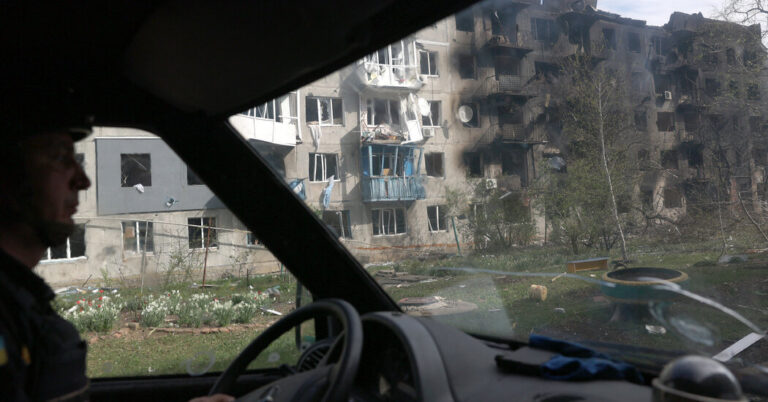Russian troops have captured or entered around a half-dozen villages on Ukraine’s eastern front over the past week, highlighting the deteriorating situation in the region for outgunned and outnumbered Ukrainian forces as they wait for long-needed American military aid.
“The situation at the front has worsened,” Gen. Oleksandr Syrsky, Ukraine’s top commander, said in a statement on Sunday in which he announced that his troops had retreated from two villages west of Avdiivka, a Ukrainian stronghold in the east that Russia seized earlier this year, and another village further south.
Military experts say Moscow’s recent advances reflect its desire to exploit a window of opportunity to press ahead with attacks before the first batch of a new American military aid package arrives in Ukraine to help relieve its troops.
Congress recently approved $60 billion in military aid for Ukraine, and President Biden signed it last week, vowing to expedite the shipment of arms.
“In an attempt to seize the strategic initiative and break through the front line, the enemy has focused its main efforts on several areas, creating a significant advantage in forces and means,” General Syrsky said on Sunday.
Here’s a look at the current situation.
A slow but steady advance near Avdiivka
General Syrsky said the “most difficult situation” at the moment was around the villages west of Avdiivka, which Russia captured in February after months of fierce battles. He said Russia had deployed up to four brigades in the area with the goal of advancing toward Ukrainian military logistical hubs, such as the eastern city of Pokrovsk.
After Russia captured Avdiivka, Ukrainian forces fell back to a new defensive line about three miles to the west, along a series of small villages, but that line has now been overrun by Russian forces. General Syrsky said on Sunday that his troops had withdrawn from Berdychi and Semenivka, the last two villages in that area that were not yet under full Russian control.
Serhii Kuzan, the chairman of the Ukrainian Security and Cooperation Center, a nongovernmental research group, said the Ukrainian command had to make “a choice between a bad situation and an even worse one” and decided to lose territories rather than soldiers.
Further complicating the situation, Russian forces have managed to break through the northern part of this defensive line by exploiting a gap in Ukrainian positions and quickly advancing into the village of Ocheretyne. That village sits on a road leading to Pokrovsk, about 18 miles to the west. It is unclear whether Russian forces have gained full control of it.
The offensive on Chasiv Yar
The Institute for the Study of War, a Washington-based think tank, said on Sunday that Russia’s gains in Ocheretyne presented the Russian command with a choice: continue to push west toward Pokrovsk, or push north toward Chasiv Yar, a town that has suffered relentless Russian attacks in recent weeks.
As many as 25,000 Russian troops are involved in an offensive on Chasiv Yar, according to Ukrainian officials. Chasiv Yar, about seven miles west of Bakhmut, lies on strategic high ground.
Its capture would put the town of Kostiantynivka, some 10 miles to the southwest, in Moscow’s direct line of fire. The town is the main supply point for Ukrainian forces along much of the eastern front.
A push northward from Ocheretyne could also allow the Russian forces to attack Kostiantynivka from the south, in a pincer movement.
“Russian forces currently have opportunities to achieve operationally significant gains near Chasiv Yar,” the Institute for the Study of War said in its report on Sunday.
Tough weeks ahead
Mr. Kuzan, the military expert, said that Russian advances “will continue to happen in the near future, depending on how quickly and in what volume Western aid will arrive.”
The United States said last week that it would rush the first $1 billion of its new military aid package to Ukraine. That batch will include shoulder-fired Stinger surface-to-air missiles and other air defense munitions, Javelin anti-tank guided missiles and 155-millimeter shells.
Ukraine is particularly desperate for artillery shells, essential to pound the enemy and constrain its movements. Speaking to Western allies last week, President Volodymyr Zelensky said that Russia currently fires 10 shells for every shell Ukraine fires.
But whether these supplies will reach the battlefield quickly enough to stop the Russian advances remains uncertain.
Military experts have said that Russia is preparing to launch a new large-scale offensive in late May or early June, and that it will press ahead with attacks in the coming weeks. Volodymyr Bitsak, a Ukrainian commander, told national television on Monday that Russia had deployed four battalions near the border with Ukraine’s northeastern Sumy region.
“We are still waiting for the supplies promised to Ukraine,” Mr. Zelensky said in his nightly address on Sunday. He added that he had just spoken to Hakeem Jeffries, a Democrat who is the minority leader in the U.S. House of Representatives, about the delivery of the American military aid package.
“We expect exactly the volume and content of supplies that can change the situation on the battlefield,” Mr. Zelensky said.
During a visit to Kyiv on Monday, Jens Stoltenberg, the NATO secretary general, said the many months it took Congress to approve new military assistance to Ukraine and Europe’s failure to deliver ammunition on time had led to “serious consequences on the battlefield.”
“It’s about life and death,” Mr. Stoltenberg said during a news conference. “When we are not delivering as we should, then Ukrainians are paying the price.”
Lara Jakes contributed reporting.

